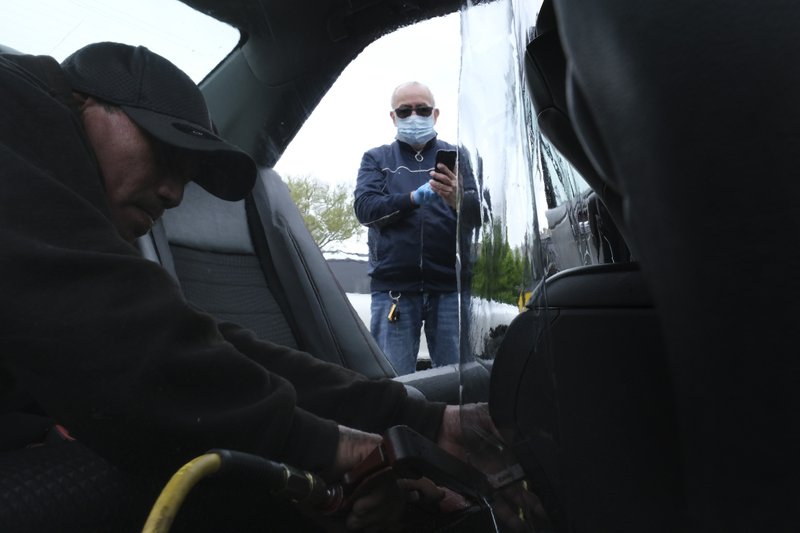Ride-hailing giants Uber and Lyft are requiring drivers and passengers to wear masks while using their services, joining a growing list of transportation companies hoping to mitigate the spread of COVID-19 as some cities emerge from lockdown.
All major U.S. airlines have already rolled out requirements for passengers and crew to wear face coverings in response to concerns over contagion, particularly in small or confined spaces that present higher risks of infection than well-ventilated or outdoor settings.
But the rules are only effective if people are willing to follow them and if the companies ferrying passengers are serious about enforcement.
Pilots worry that travelers could remove their masks and spark a confrontation with others during a flight. They are pressing the Federal Aviation Administration to require masks instead of leaving it up to individual airlines.
“I can’t imagine the stir on the airplane if someone takes off their mask,” said Dennis Tajer, a 737 pilot and spokesman for the pilots’ union at American Airlines. “It puts the flight crew in a precarious position.”
In ride-hailing vehicles, Uber will make drivers upload a mask-wearing selfie into the app before they can pick up a passenger, the company said Wednesday. Riders also will be required to wear a mask, but they won’t have to provide proof. Either the rider or driver can cancel a ride if the other doesn’t wear a mask, and repeat violators can be kicked off the platform.
Lyft is providing one reusable cloth mask to each driver and has been distributing hand sanitizer. Uber has distributed disposable masks or cleaning supplies to about 400,000 drivers globally, distributing packs of five or ten masks and encouraging drivers to use one per day, said Sachin Kansal, Uber’s head of safety products.
Jerome Gage, who drives for Lyft in Los Angeles, says what Uber and Lyft are currently providing is not nearly enough to keep drivers and passengers safe.
“If we were to just rely on what Uber and Lyft provided to us, our cars would be like a cesspool, potentially, for this disease,” Gage said.
On airplanes, enforcement appears to be spotty at best. American Airlines has told pilots that gate agents may deny passengers from boarding if they aren’t wearing a mask but it doesn’t expect crews to continue policing once they’re in the air.
“Once on board and off the gate, the face covering policy will become more lenient,” according to an American Airlines memo to pilots. “The flight attendant’s role is informational, not enforcement, with respect to the face covering policy. The flight attendants are instructed not to escalate the issue if the passenger refuses to wear a face covering and to consider options, such as reseating if other passengers are involved, to defuse the situation.”
An official with another airline, who wasn’t authorized to discuss the airline’s procedures and requested anonymity, described a similar policy. “We don’t want our crews to be police,” the person said. Instead, crews will report uncooperative passengers to the airline’s security office when the flight is over, the person said.
Even with enforcement, the effectiveness of masks is questionable, especially on planes when passengers remove them for snacks and drinks, touch their faces and spread germs. And in general, many people are donning masks incorrectly, in ways that could increase risks, experts said.
“If you’re going to wear a mask, you need to very consciously learn to wear it correctly, otherwise they’re not effective, and it can actually become a hazard to you if you don’t treat it like it’s a protection device,” said Joshua Santarpia, associate professor of pathology and microbiology at the University of Nebraska Medical Center.
Different masks also provide different levels of protection against germs. The N95 masks worn by medical professionals are considered most effective, but many people don’t have them. And cloth masks are so varied that it’s difficult to know how much protection they provide. Even so, experts say some kind of mask is probably better than nothing since it can help keep some viral droplets from spreading.
Several experts said wearing a mask while taking an Uber or Lyft is probably safer than taking public transportation, where riders are exposed to more people. Some cities have rules requiring masks on buses or trains, but restrictions vary from one city to the next. Lyft drivers and riders can also decline a ride if they don’t feel safe. And Uber is encouraging drivers and riders to roll down windows to improve air flow.
Airlines are taking additional measures beyond mask requirements to protect passengers, including blocking some middle seats to create space between passengers and stepping up cleaning.
Nonetheless, passengers are still touching seats on their way to the bathroom and leaving germs on doorknobs, faucets and hundreds of potential places throughout their airplane and departure lounge, said Timothy Sly, epidemiologist and professor emeritus at the School of Public Health at Ryerson University in Toronto.
For those reasons, he probably wouldn’t get on a plane.
“It doesn’t make any sense at all, when you look at the precautions we put in place, and then we pack all these people in like sardines, breathing each other’s air,” Sly said.
(AP)











